
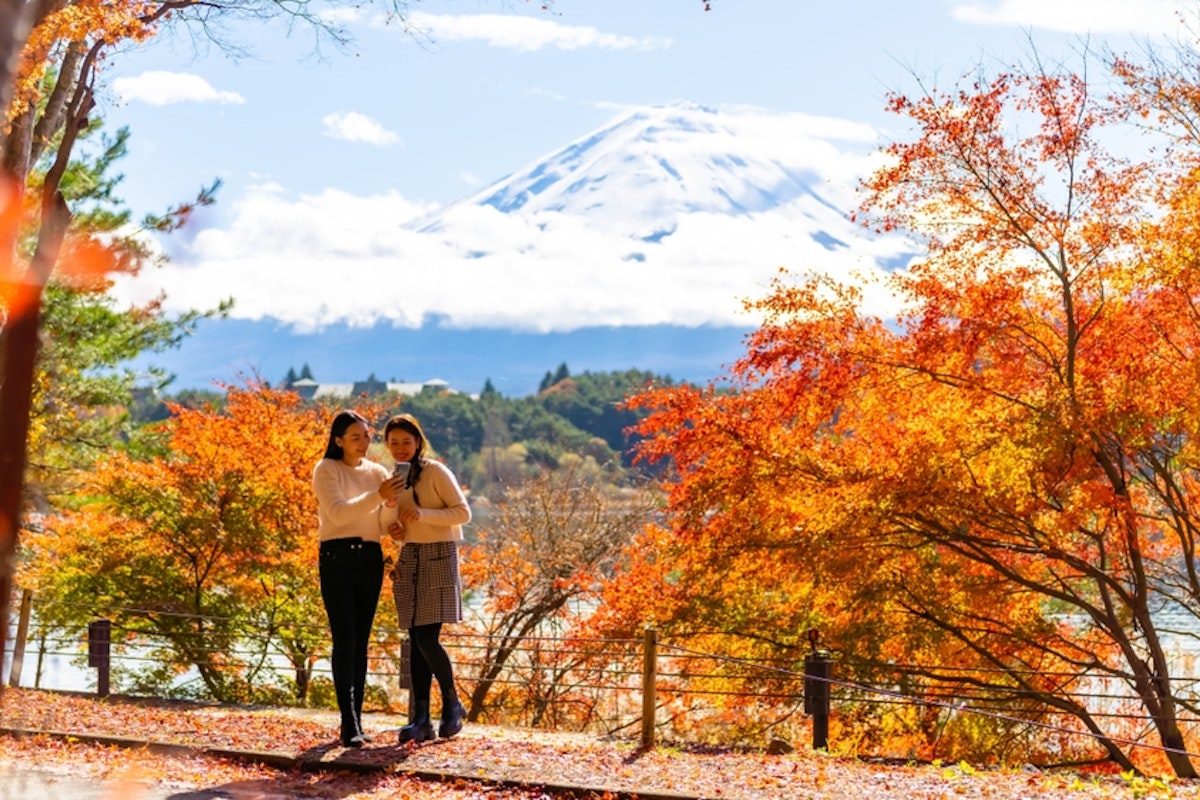
As the sweltering summer days give way to the cooler, crisp air of autumn, Japan transforms into a breathtaking canvas painted with hues of fiery reds, brilliant oranges, and golden yellows. This season, known as "koyo" in Japanese, is just as eagerly anticipated as cherry blossom season, attracting nature lovers, photographers, and travelers from around the globe.
Autumn in Japan is not just about the stunning fall foliage but also about harvest festivals, autumnal foods, hot springs, and cultural experiences that provide a unique insight into the country's rich traditions.
Autumn in Japan is a season of spectacle, celebrated for its breathtaking beauty and unique traditions. The colourful transformation of the landscape during this period is what truly makes autumn special in Japan. One such tradition that enhances the charm of the season is 'Momijigari', translated as 'autumn leaf hunting'.
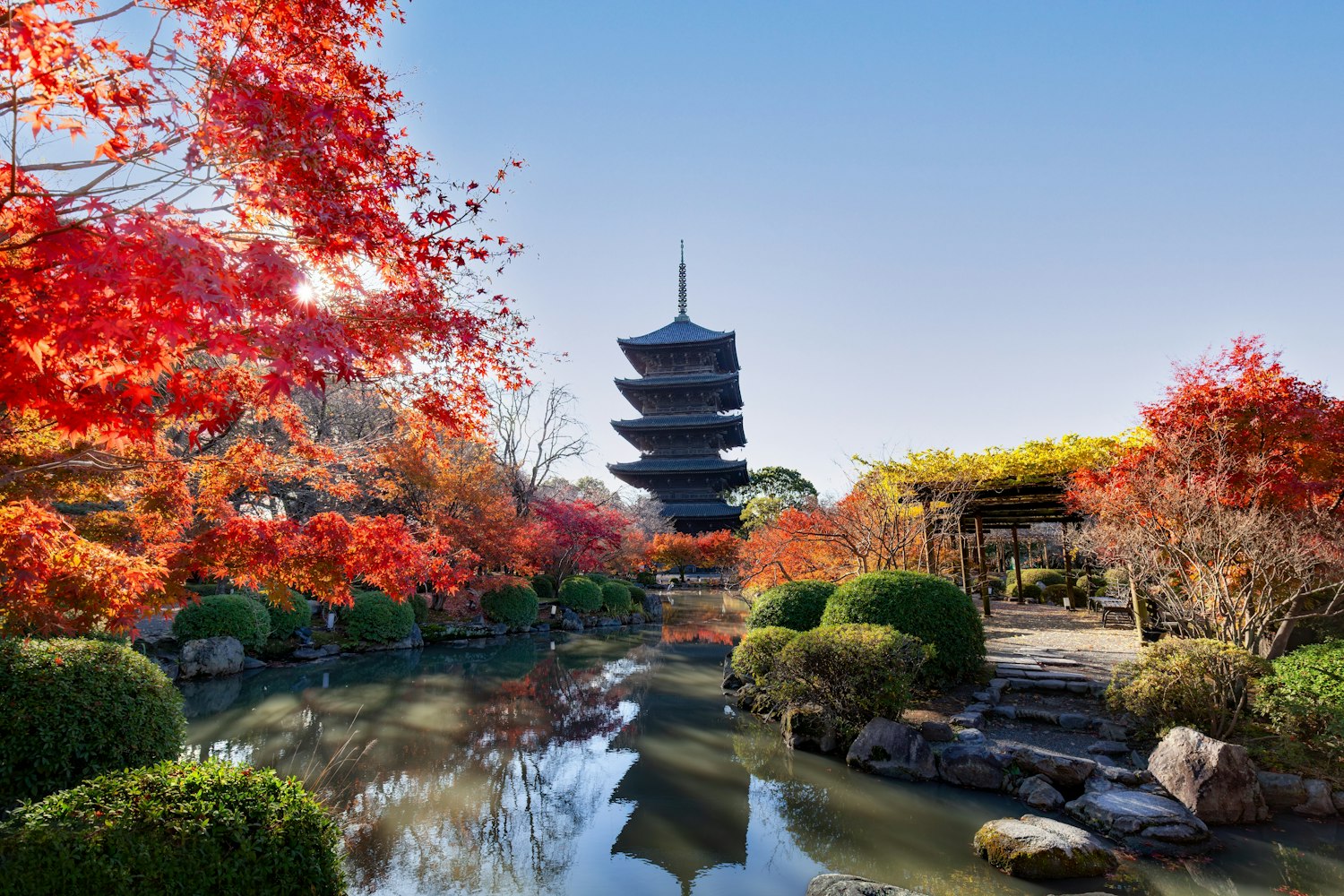
This tradition involves people traveling to areas where leaves have turned red to appreciate the natural beauty, a practice which dates back centuries. The term 'Momiji' refers to the Japanese maple tree that turns a brilliant, fiery red during autumn, while 'Koyo' refers to the changing colours of autumn leaves in general.
'Momiji', or Japanese maple, and 'Koyo', signifying the changing colours of autumn foliage, are two concepts that hold significant cultural importance in Japan. The momiji leaves turn a vibrant red, creating a spectacular contrast with the surrounding greenery and the clear autumn sky.
'Koyo' encompasses the broader phenomenon of autumn leaves changing colour – from green to yellow, orange, and finally to red. This natural spectacle is highly regarded and celebrated for its exceptional beauty, with the activity of searching for the most striking shades of leaf known as 'Momijigari'.
The transformation of green landscapes into hues of yellow, orange, and red begins in the northern regions of Japan in late September and gradually moves southward, ending in the southern regions around early December. The northernmost of Japan's islands, Hokkaido, is an excellent place to start your autumn journey.
As autumn progresses, you can move to the southern parts of the country to continue experiencing the magic of Momiji. Therefore, the best time for autumn travel in Japan spans from late September to early December. However, specific dates may vary each year due to weather patterns and climate conditions.
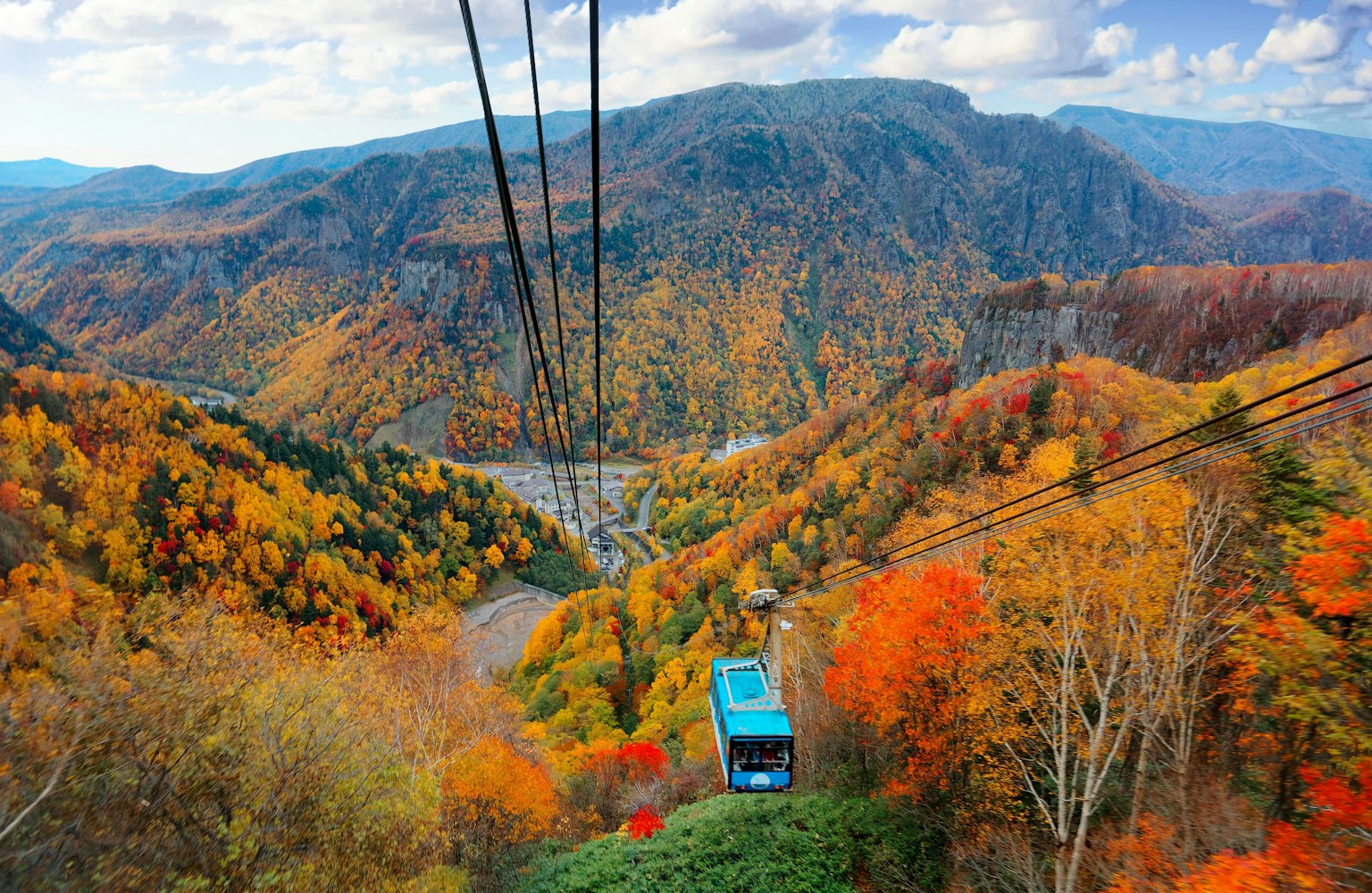
Hokkaido, the northernmost island of Japan, is a paradise for nature lovers and outdoor enthusiasts. The region is especially captivating during autumn, as the foliage transforms into vibrant colors, creating a stunning backdrop against traditional architecture and natural landscapes. Whether you're exploring major cities, hiking trails, or relaxing in a hot spring town, Hokkaido offers an unforgettable autumn experience.
Daisetsuzan National Park, the largest national park in Hokkaido, is a must-visit destination for those seeking adventure and stunning autumn scenery. Known as 'the playground of the gods,' this national park preserves a vast wilderness area, which is home to towering mountains, alpine flowers, rare plants, and animals.
During autumn, the park's maple trees turn into vibrant hues of red and yellow, providing a breathtaking display of fall foliage. Hiking trails offer visitors the opportunity to immerse themselves in this spectacular landscape. Remember to pack your hiking boots, as the park's rugged terrain can be challenging but rewarding.
Onuma Park, located in southwestern Hokkaido, is another beautiful destination to add to your autumn itinerary. The park is known for its serene lake surrounded by maple and cherry trees, which provide a stunning display of autumn colors.
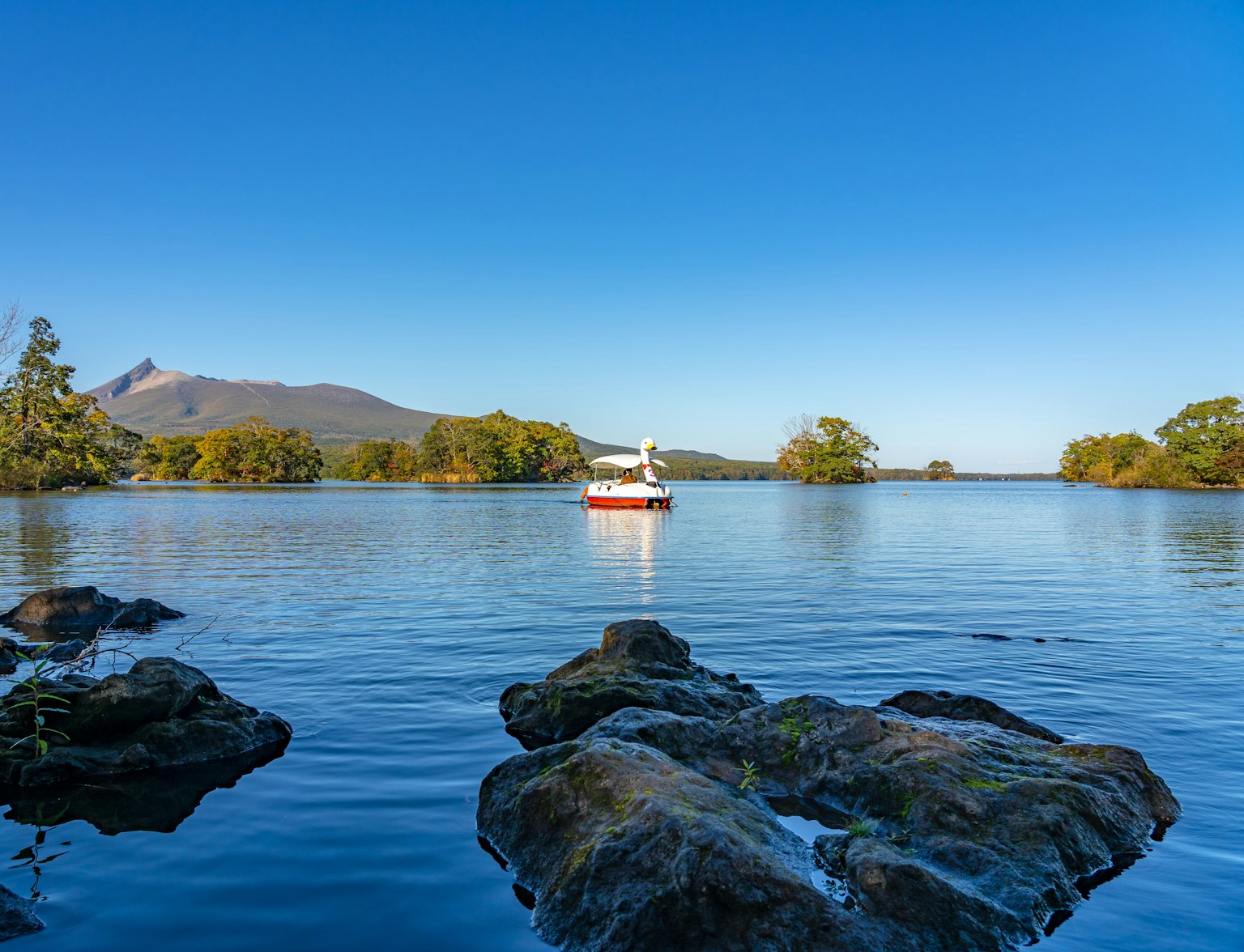
Start your trip in Hakodate with a peaceful stroll through Onuma Park.
The contrast of the calm water with the vibrant leaves creates a picture-perfect scene, making it a favorite spot for photographers and nature lovers alike. In addition to enjoying the scenery, visitors can also explore the park's walking trails, rent a boat, or visit the nearby hot spring town for a relaxing soak.
The Tohoku region, located in the north of Japan's largest island, Honshu is renowned for its unspoiled rural landscapes, historical treasures, and stunning natural beauty. The region, consisting of six prefectures, offers rugged, mountainous terrain and rows of river lowlands that make up almost one-fifth of Japan's land area. Its inland location and unique geographical features create a breathtaking canvas for autumn, where the hills and mountains are painted with vibrant hues of red, orange, and gold.
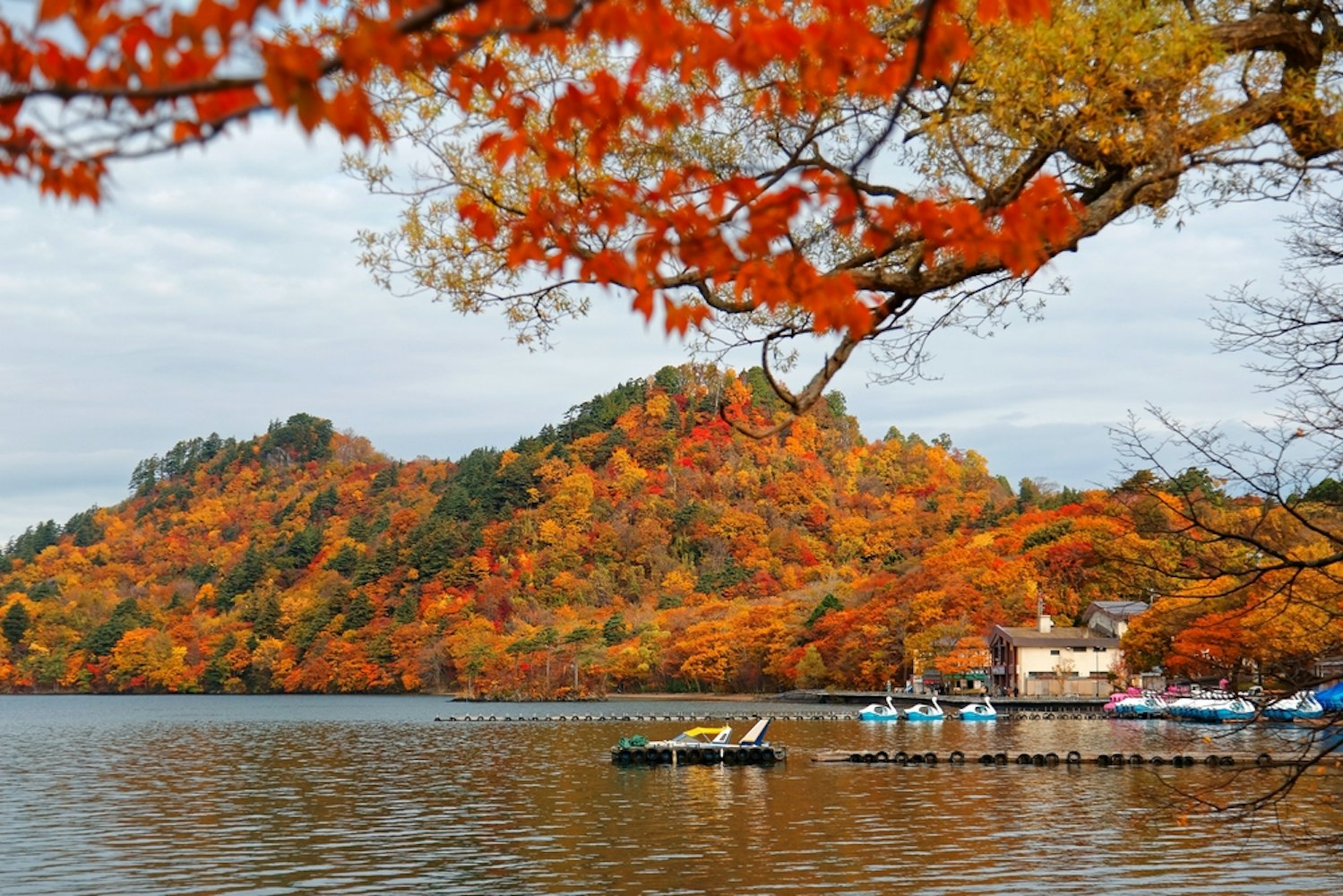
Lake Towada, one of the most scenic spots in the Tohoku region, offers a mystical autumn experience. It's a caldera lake nestled between the peaks of the Towada-Hachimantai National Park, known for its clear blue waters and surrounding foliage that turns into a riot of colors in autumn.
The lake's serene atmosphere and stunning beauty make it an ideal destination for nature lovers and photographers alike. Visitors can take a leisurely boat ride on the lake, explore the nearby Oirase Stream walking trails or simply soak in the tranquil scenery.
Naruko Gorge, another gem in the Tohoku region, is a sight to behold during the autumn season. The gorge is famed for its kaleidoscope of colors, as the leaves of thousands of trees change color, creating a spectacular display of reds, oranges, yellows, and greens.
A walking trail winds through the gorge, offering visitors a chance to immerse themselves in this mesmerizing landscape. The Onikobe Geyser, located nearby, is also worth a visit. The spray of water against the backdrop of colorful autumn leaves creates a magical scene, enhancing the overall experience at Naruko Gorge.
The Kanto region, located in the eastern part of Honshu, the largest island of Japan, is a bustling hub of cultural and natural attractions. Known for the Greater Tokyo Area, this region is a blend of urban sophistication and rural charm.
The region is densely populated, yet it retains pockets of stunning natural beauty, from tranquil gardens to vibrant autumn foliage. As the leaves change color in the fall, the region transforms into a picturesque wonderland, offering travelers a chance to witness the vibrant autumn colors and enjoy the fall foliage.

Rikugien Garden, located in the residential part of Bunkyo City in northern Tokyo, is a sprawling haven of tranquility amidst the bustling cityscape. The name Rikugi-en translates to "Garden of the Six Principles", which refers to the six elements in waka, a type of traditional Japanese poetry. As such, the garden is a living embodiment of classical Japanese aesthetics and an elegant representation of poetic inspiration.
The garden is quite spacious, and it takes about an hour to cover its entire network of walking paths at a leisurely speed. The paths lead visitors through an array of beautiful landscapes, including three teahouses and a large pond. Rikugien is particularly famous for its weeping cherry blossom trees and autumn leaves. Visitors are advised to arrive early during peak seasons to avoid crowds and fully savor the serene beauty of the place.
Mount Takao, also located in the Kanto region, offers another unique way to experience the autumn season in Japan. Known for its accessibility and stunning views, Mount Takao is a popular destination for both locals and tourists looking to enjoy the outdoors without straying too far from the city.
While the mountain may not be as high as others in the country - standing at just 599 meters - what it lacks in height it more than makes up for with its beautiful landscapes and rich biodiversity. In fact, Mount Takao is known to have one of the greatest numbers of different species per area in the world, making it an ideal spot for nature lovers.
The hiking paths on Mount Takao are well-maintained and clearly marked, catering to hikers of all skill levels. Among the various trails, the most popular is Trail 1, which leads to the mountain's summit where you can enjoy panoramic views of Tokyo and beyond. During autumn, the mountain becomes a spectacle of vibrant colors as the leaves change, creating a breathtaking backdrop for your hike.
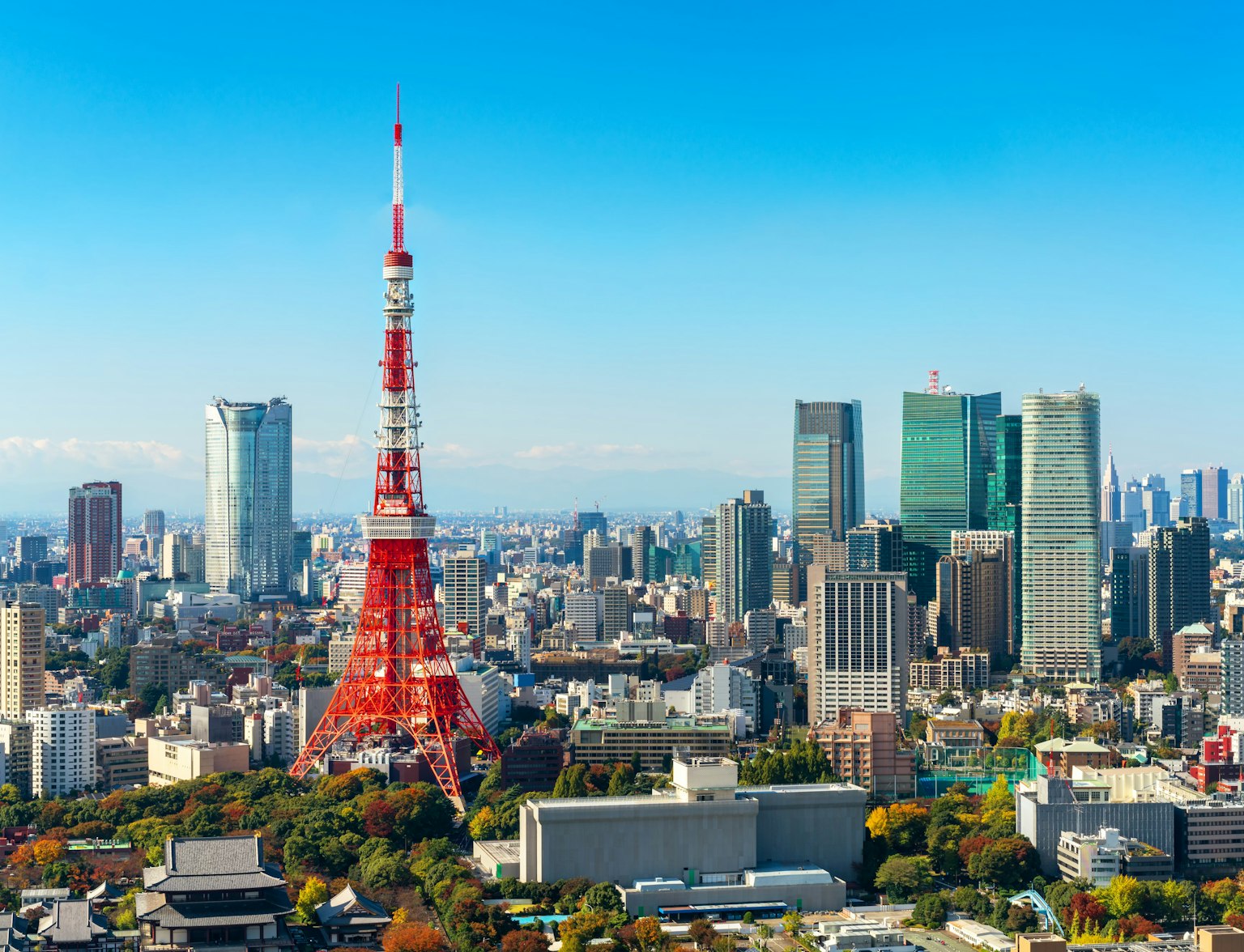
Include these sights on your custom itinerary with a private vehicle.
The Chubu region, located in the heart of Honshu, is often referred to as the "central part" of Japan. This region boasts nine prefectures and offers coastlines along both the Pacific Ocean and the Sea of Japan. Renowned for its spectacular autumn colors, the Chubu region is a must-visit on any Japan autumn itinerary. Whether you're visiting Japan for a few days or planning a two-week Japan itinerary, this region offers stunning autumn destinations.
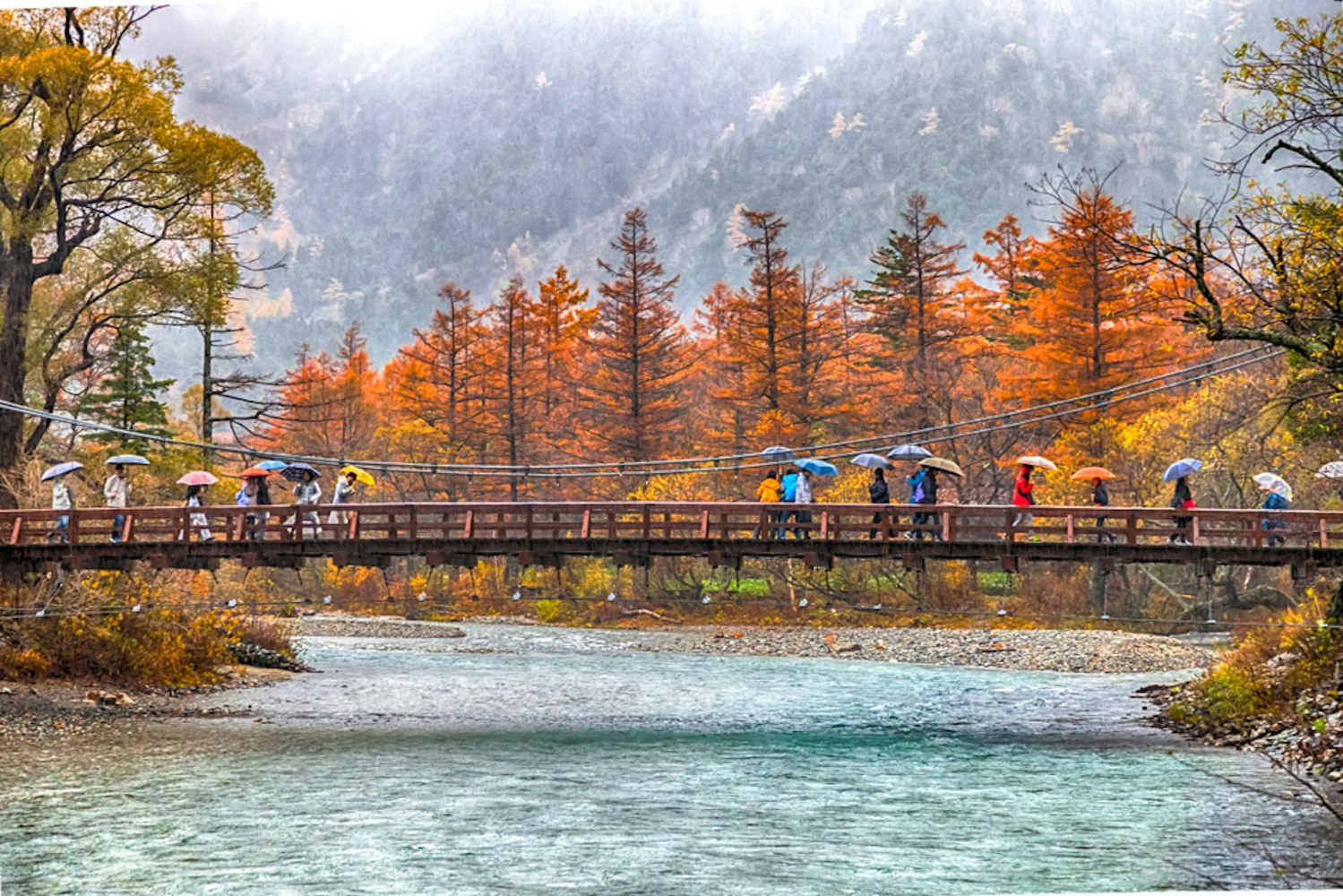
Kamikochi, located in the Japanese Alps within the Chubu region, is a popular destination for nature lovers and outdoor enthusiasts. Known for its pristine landscapes and stunning scenery, Kamikochi offers a unique opportunity to enjoy fall foliage amidst a backdrop of towering peaks and crystal-clear waters.
During the fall season, from mid-October to early November, Kamikochi transforms into a vibrant canvas of colorful autumn foliage. The yellow leaves of the ginkgo trees contrast beautifully with the red and orange hues of other trees, creating a breathtaking sight. A day trip to Kamikochi during this season allows visitors to experience the beautiful autumn destinations of Chubu, making it a highlight in any Japan trip.
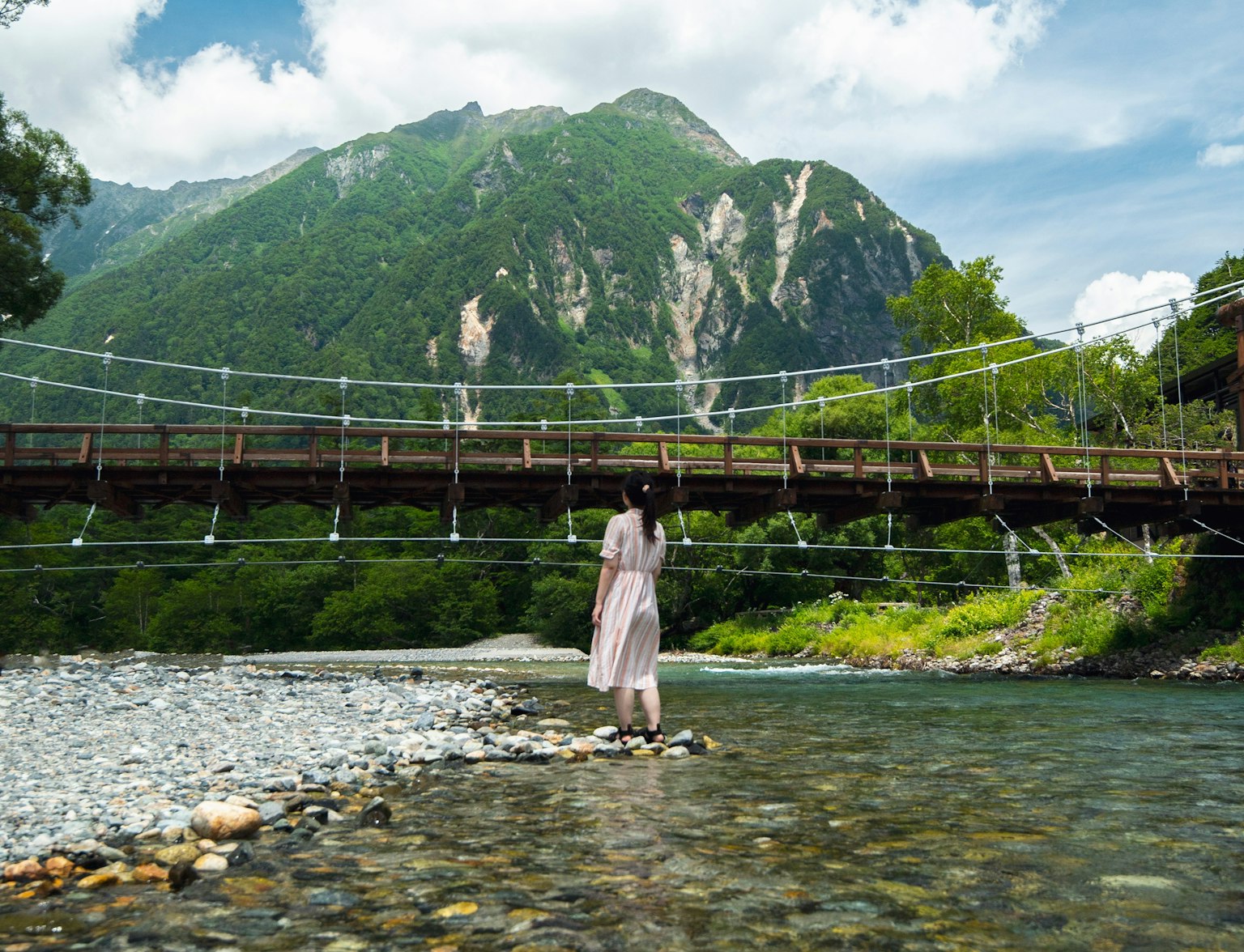
Visit one of Japan's leading mountain resorts known for its breathtaking natural beauty.
Shiga Kogen, another gem in the Chubu region, is one of the best places to see autumn colors in Japan. This area is known for its vast highland, which becomes a carpet of stunning autumn colors during the fall season.
In early October, Shiga Kogen begins its transformation into a vibrant display of autumn colours. The area is covered in bright yellow, orange, and red leaves, offering breathtaking scenery for autumn leaf viewing. The colorful trees create a stunning contrast against the traditional thatched roof houses of the area, making Shiga Kogen a must-visit spot during a Japan autumn itinerary.
The Kansai region, also known as Kinki, is the historical heart and cultural capital of Japan. With bustling cities like Kyoto, Osaka, Nara, and Kobe, the region is a hub of western Japan and offers a rich blend of traditional Japanese architecture, UNESCO World Heritage Sites, and stunning natural beauty. Whether you visit Japan in late October or mid-November, Kansai's vivid hues of autumn leaves make it an essential stop on any Japan trip.
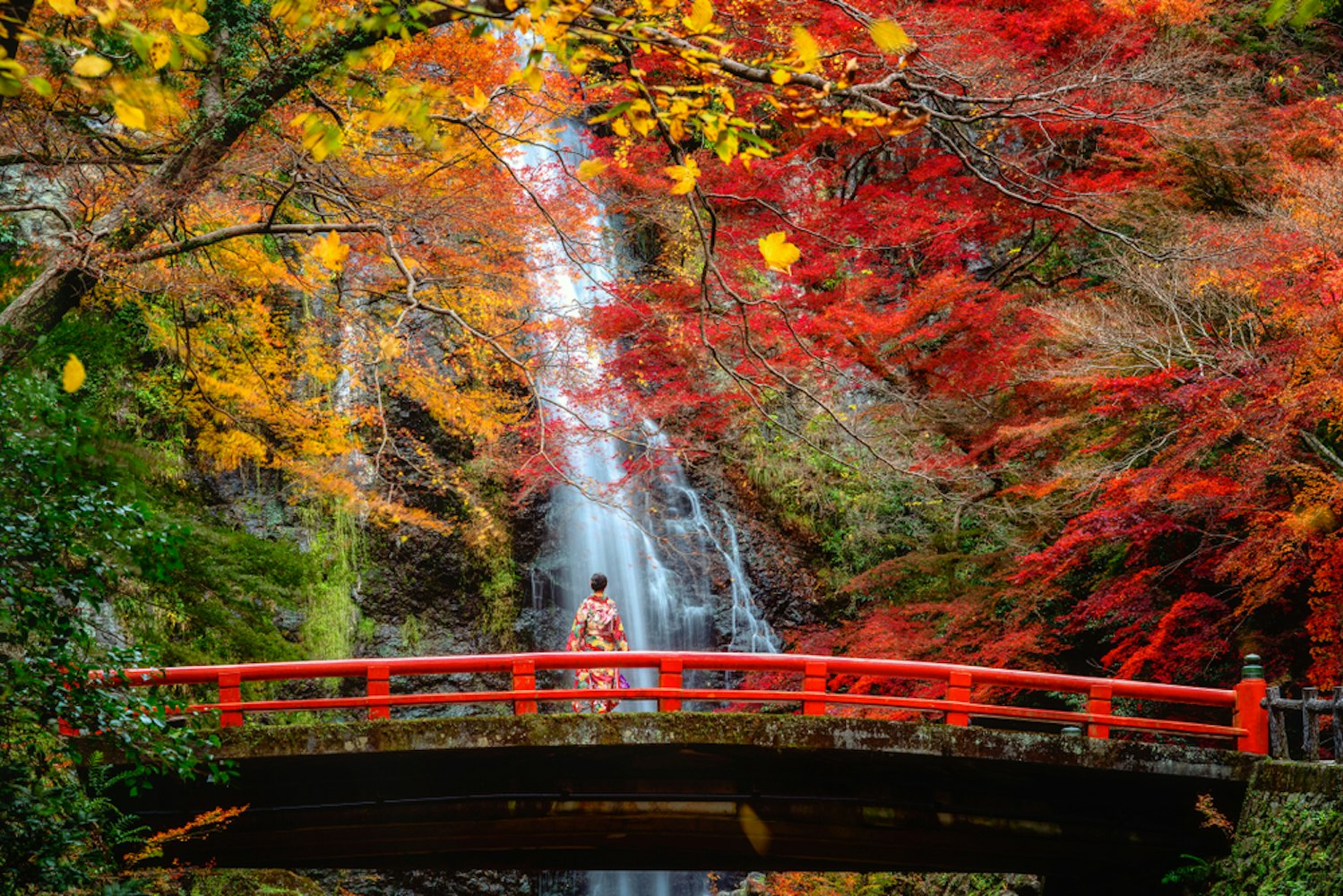
Arashiyama, located on the western outskirts of Kyoto, is renowned for its stunning foliage and traditional Japanese garden setting. This district is a UNESCO World Heritage Site and a popular destination during the fall season, offering a breathtaking display of autumn leaves in Japan.
From late October to mid-November, the maple trees lining the streets of Arashiyama transform into vibrant shades of red and orange. A day trip to Arashiyama allows visitors to enjoy a scenic boat ride along the Hozugawa River, surrounded by a panorama of colorful leaves. The serene atmosphere, combined with the traditional Japanese architecture of the temples and shrines, makes Arashiyama a must-visit spot during the autumn season.
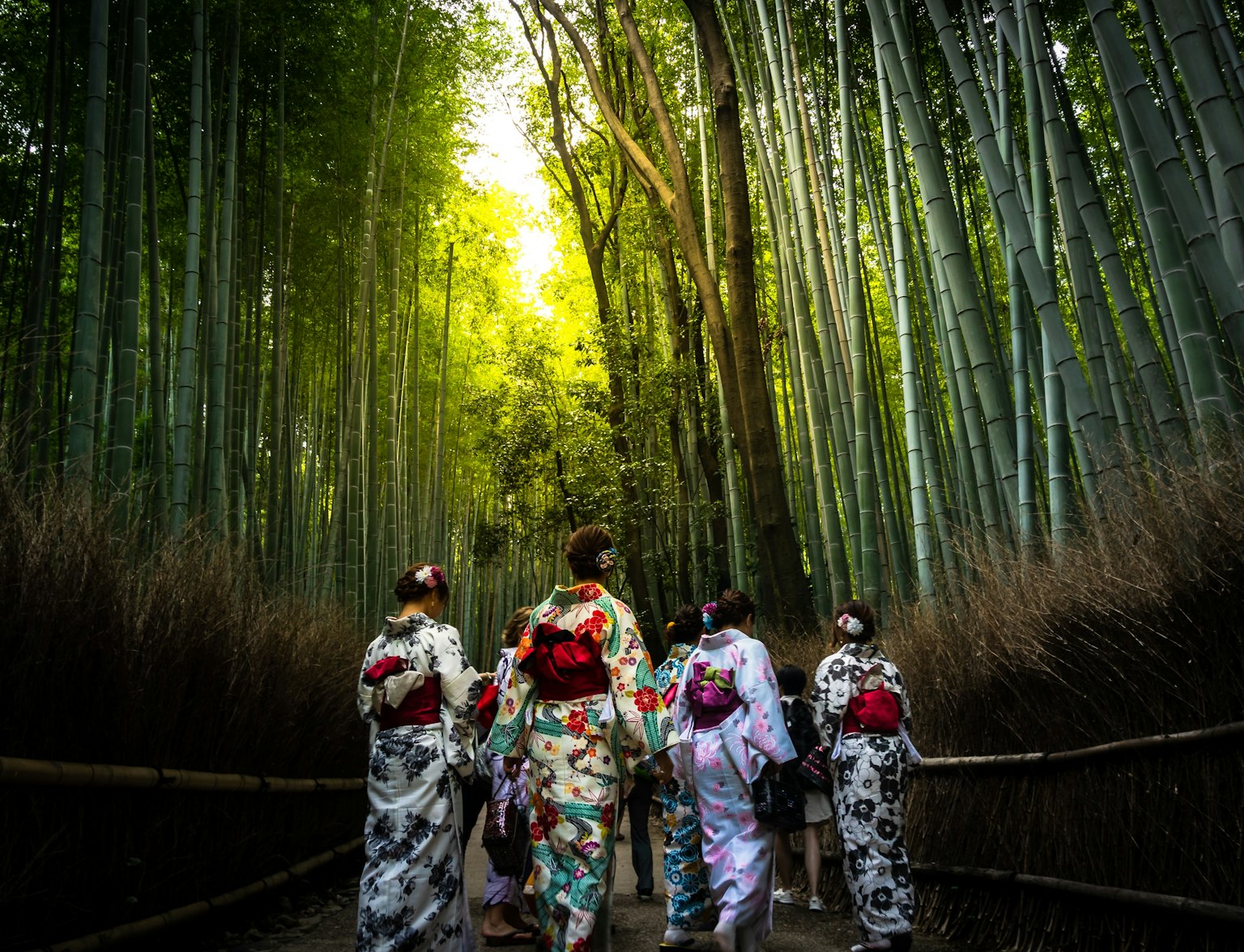
Explore Arashiyama's beautiful spots with this tour.
Minoo Park, located just north of Osaka, is another beautiful autumn destination in the Kansai region. Known for its waterfall, hiking trails, and maple leaf tempura, Minoo Park offers a tranquil escape from the bustling city life of Osaka.
In late October, the park becomes a canvas of spectacular autumn colors, with the surrounding mountains covered in vibrant shades of red, yellow, and orange. The park's main path, leading to the Minoo Waterfall, offers a stunning view of the autumn leaves reflecting off the water. A visit to Minoo Park during the fall season is an excellent opportunity to experience the chilly nights of November and the stunning foliage of Western Japan.
The Chugoku Region, located in the western part of Honshu, comprises five prefectures and is often referred to as the "central country". Known for its historical sites and diverse natural beauty, Chugoku offers a unique blend of traditional Japanese architecture and stunning landscapes. Whether you're planning to visit Japan in November or early December, the autumn colors in this region are sure to captivate you.
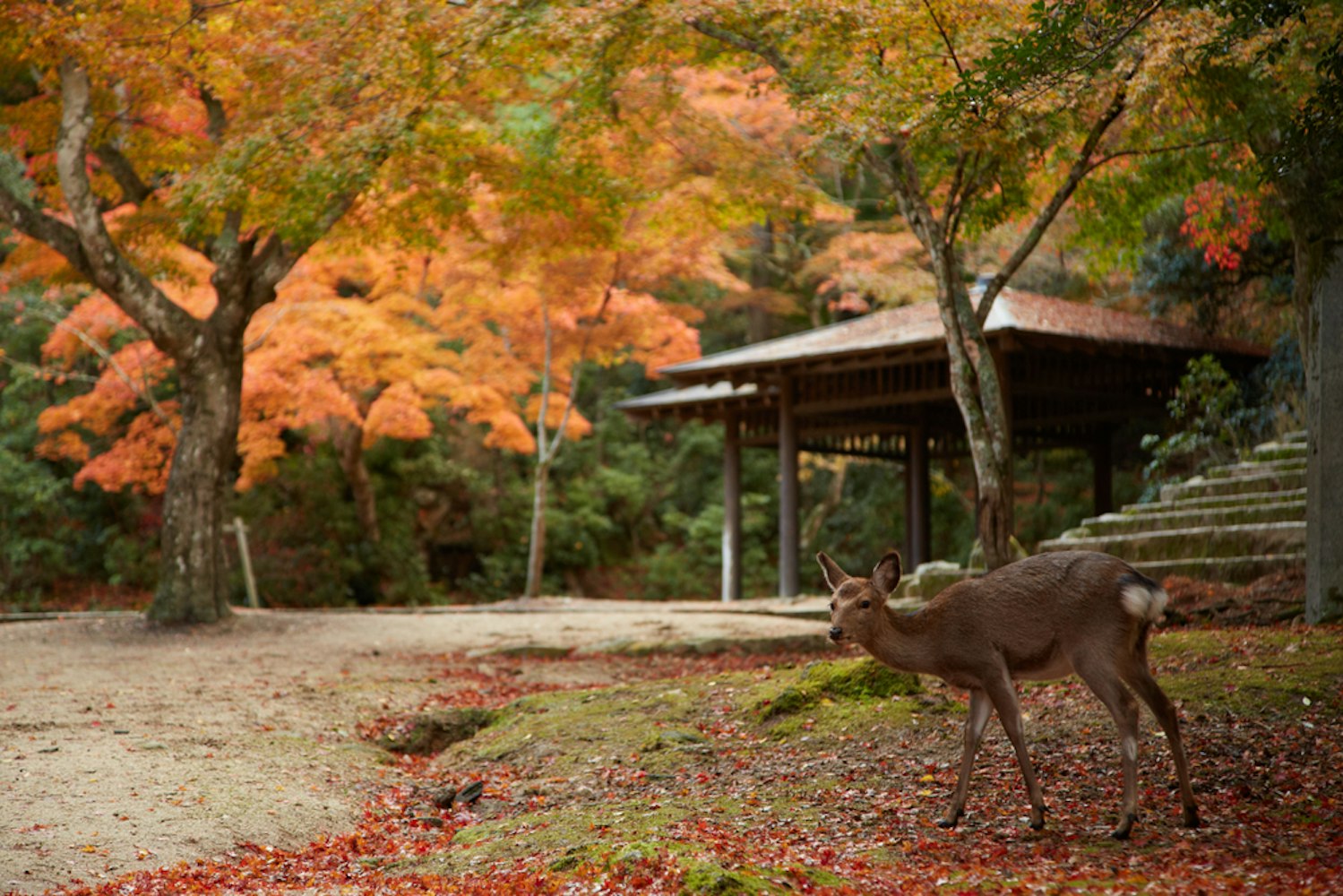
Miyajima, officially known as Itsukushima, is an island in the western part of the Inland Sea of Japan, located in the northwest of Hiroshima Bay. As a UNESCO World Heritage Site, Miyajima is renowned for its stunning fall foliage and rich cultural heritage.
From late October to mid-November, the island transforms into a vibrant display of autumn leaves, offering vivid hues of red, orange, and yellow. The contrast of the colorful leaves against the backdrop of Itsukushima Shrine, a traditional Japanese architecture, creates a breathtaking view. A visit to Miyajima during the autumn season is an opportunity to experience the beautiful blend of nature and heritage that makes up the Chugoku Region.
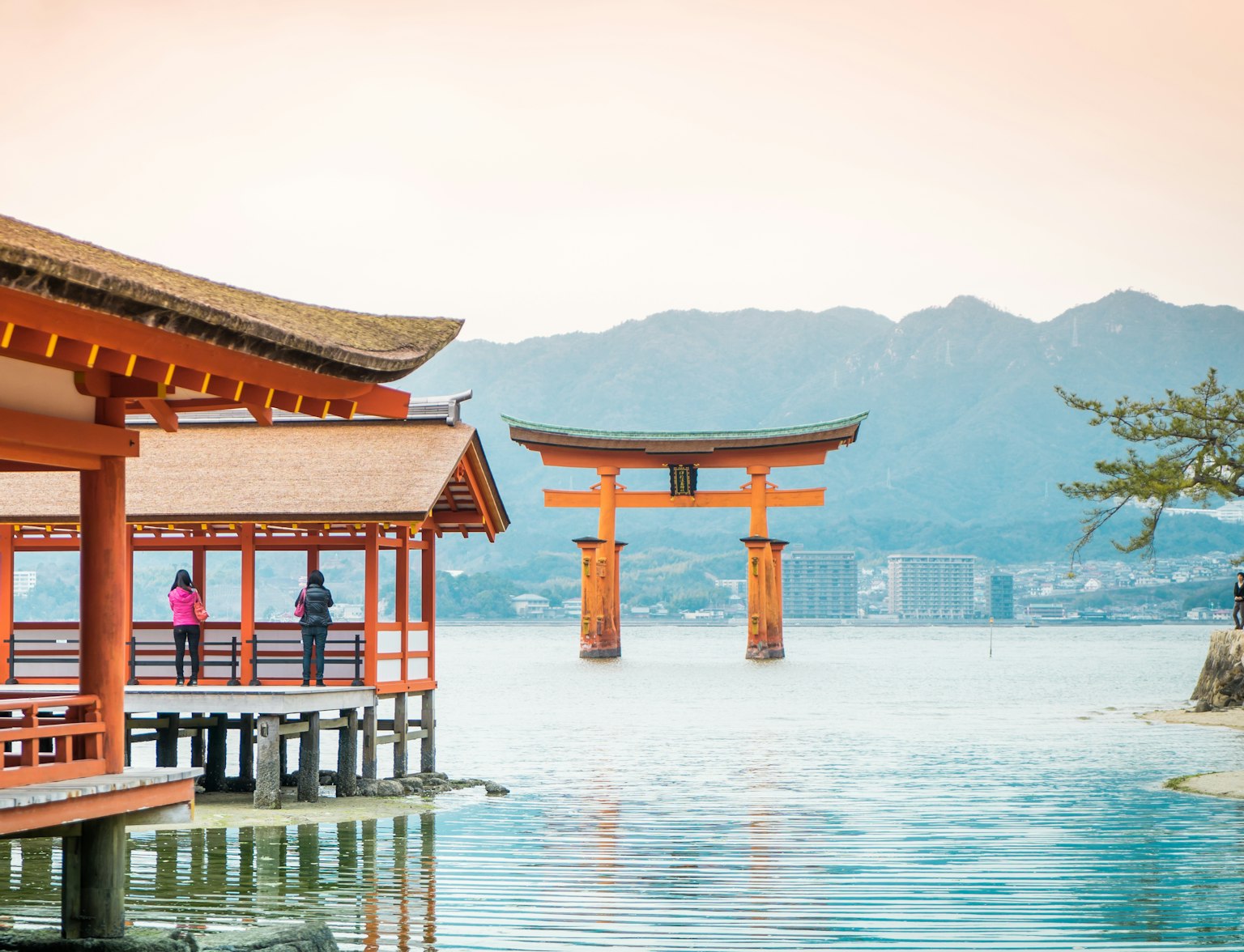
Enjoy a delectable local lunch and soak up the tranquil ambiance in Miyajima.
The Tottori Sand Dunes, located in Tottori Prefecture in the Chugoku Region, offers a unique and contrasting display of nature’s colors in the fall. Spanning approximately 16 kilometers along the coast, these are the largest sand dunes in Japan and a popular tourist attraction.
During the autumn season, the surrounding mountains and vegetation change into vibrant autumn colors, creating a stark contrast against the sandy landscape. The combination of the golden sand dunes, colorful leaves, and blue sea creates a unique and stunning scenery that is truly a sight to behold. A visit to the Tottori Sand Dunes in the fall presents a unique experience of the Chugoku Region's diverse natural beauty.
Shikoku, Japan's fourth-largest island, is a captivating blend of natural beauty and cultural richness. Nestled between the Seto Inland Sea and the Pacific Ocean, Shikoku offers an array of stunning landscapes, from its mountainous central region to its picturesque coastline. Whether you're planning your visit to Japan in November or early December, the autumnal splendor of Shikoku is sure to leave you enchanted.
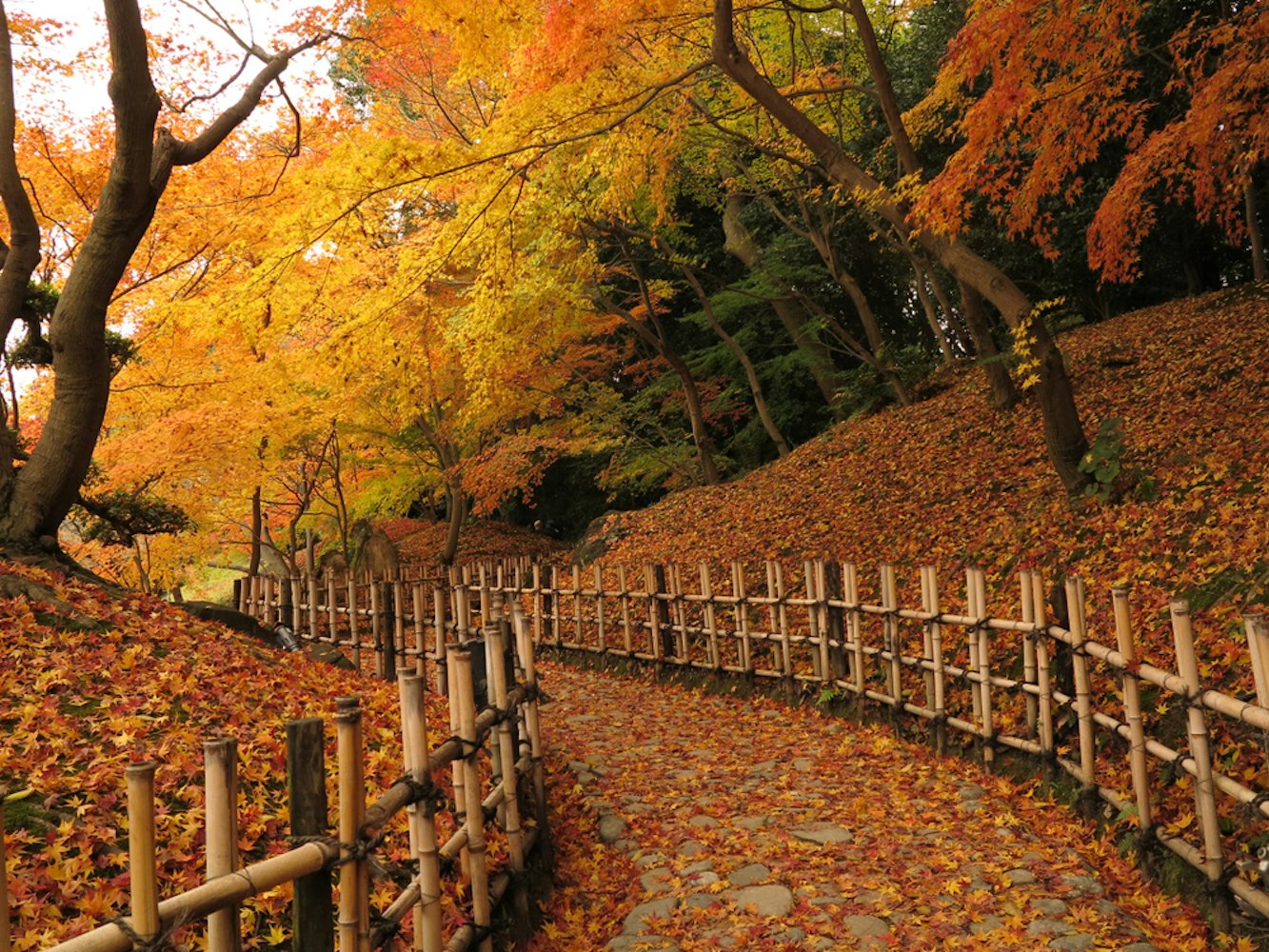
The Iya Valley, located in the heart of Shikoku, is a remote and tranquil retreat known for its steep mountain cliffs, deep river gorges, and vibrant autumn foliage. This secluded area, often referred to as one of Japan's three "hidden" regions, offers visitors a unique opportunity to experience Japan's untouched natural beauty.
From late October to mid-November, the valley's lush greenery transforms into a kaleidoscope of autumn colors. The vivid hues of red, orange, and yellow leaves contrast beautifully with the emerald green river, creating a breathtaking landscape. Whether you're exploring the valley by foot or taking a scenic drive, the Iya Valley provides a serene escape into nature during the autumn season.
Ritsurin Garden, located in Takamatsu City, Kagawa Prefecture, is one of the most famous historical gardens in Japan. Known for its meticulously manicured landscapes and traditional Japanese architecture, Ritsurin Garden offers visitors a peaceful stroll through autumn elegance.
In the fall, the garden comes alive with a symphony of autumn colors. The maple trees and other deciduous plants change into various shades of red and gold, reflecting off the garden's ponds to create a stunning visual spectacle.
A visit to Ritsurin Garden during the autumn season offers a unique opportunity to experience the traditional Japanese garden's beauty, accentuated by the vibrant colors of fall.
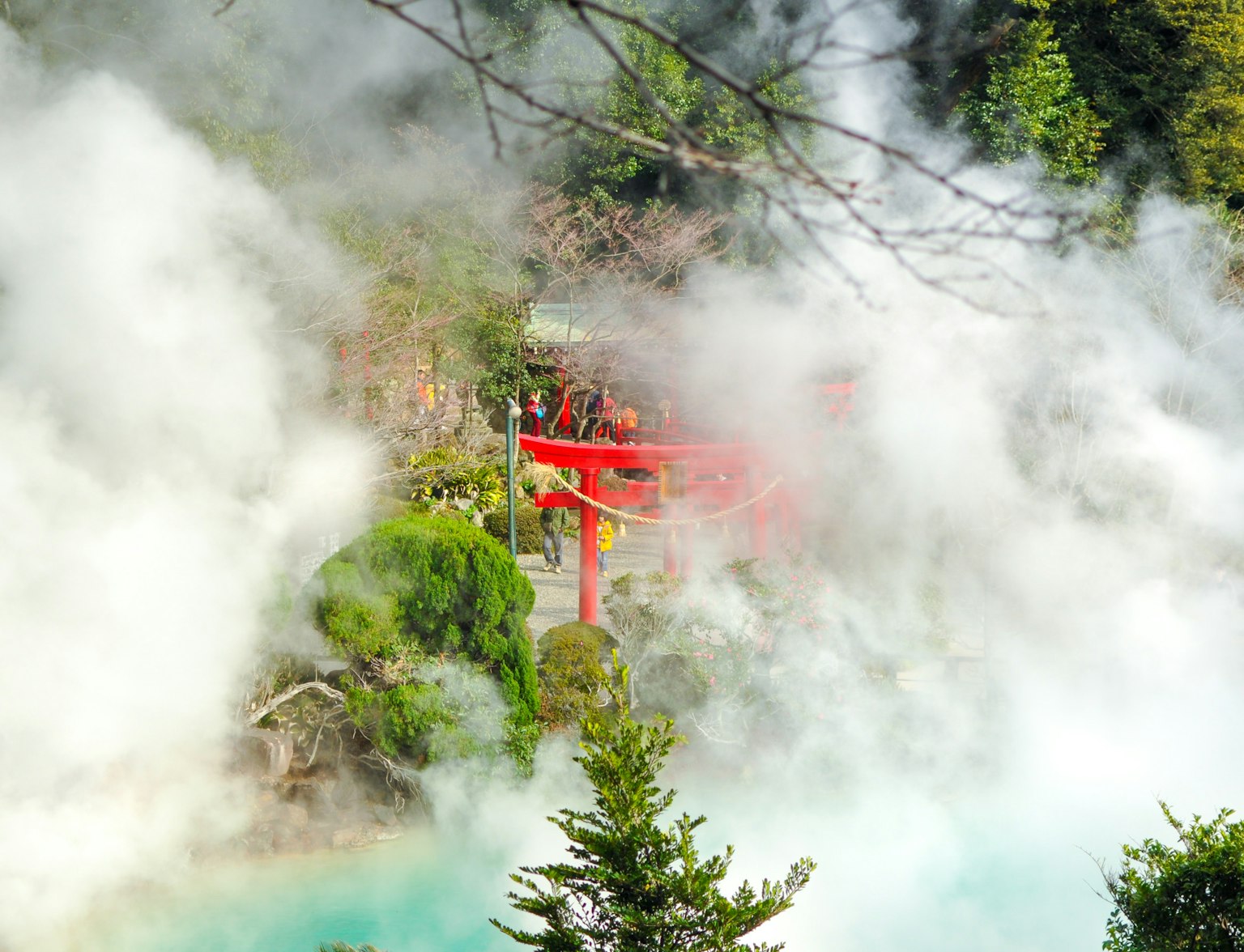
Visit Ritsurin Garden in Takamatsu at Day 7 of this tour.
The third-largest island of Japan, Kyushu, is renowned for its warmer and more tropical climate than Honshu. Known for its hot springs, active volcanoes, lush greenery, and delicious food, Kyushu offers a relaxed lifestyle that is warmly embraced by friendly locals. As autumn descends on the island, Kyushu transforms into a vivid display of fall colors, making it an excellent destination for an autumn getaway.
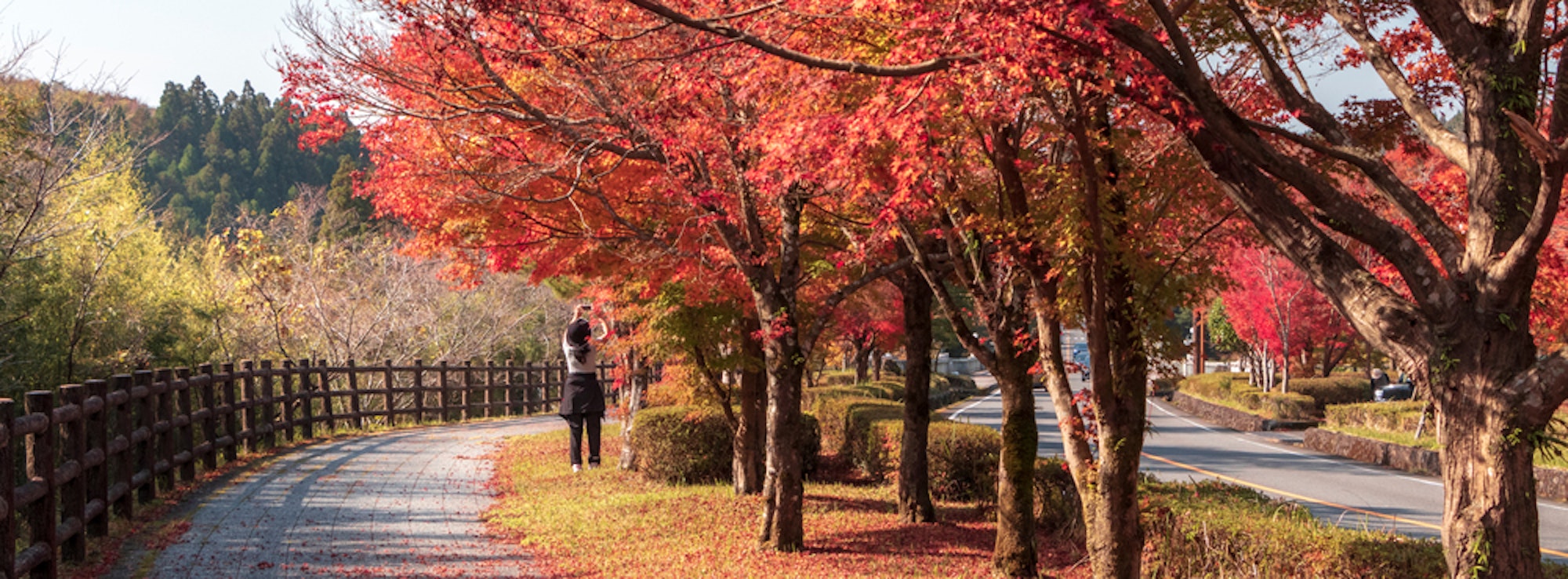
Kunenan, located in Saga Prefecture on Kyushu Island, is a hidden paradise that comes to life with vibrant autumn colors. This former private villa, only open to the public for nine days in November, features a stunning Japanese garden known for its maple trees.
As autumn progresses, the leaves of these maples transform into a vibrant display of reds, oranges, and yellows. The garden's serene atmosphere combined with its autumnal beauty creates a breathtaking landscape that captivates all who visit. Whether you're strolling through the garden or admiring the view from the villa, a visit to Kunenan during autumn provides an unforgettable experience.
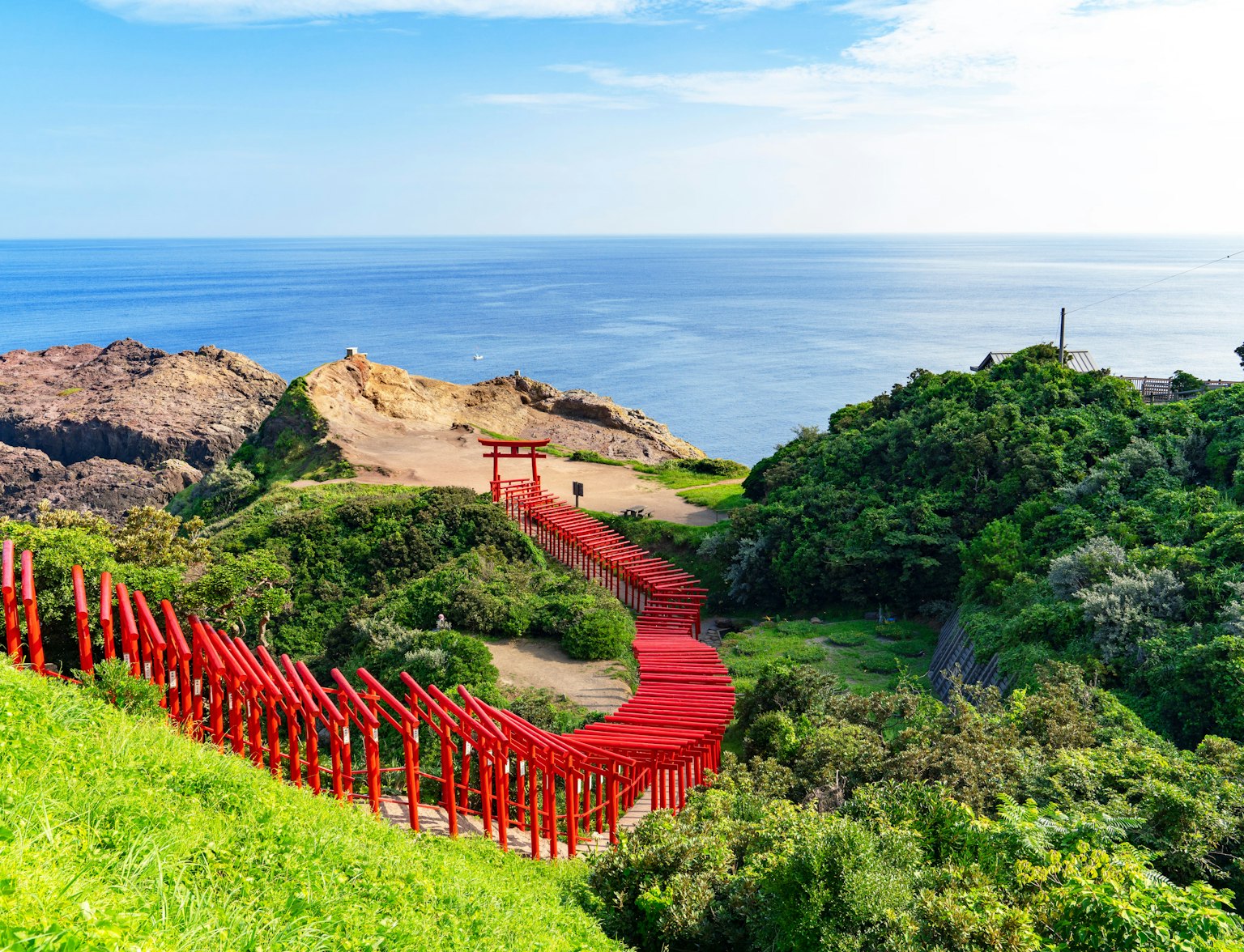
Reach Kunenan with a private bus from Fukuoka.
Kirishima, located in Kagoshima Prefecture on Kyushu Island is known for its volcanic landscapes. The area, part of the Kirishima-Kinkowan National Park, offers stunning views of active volcanoes, hot springs, and highland plateaus.
In autumn, the area's natural beauty is enhanced as the surrounding vegetation changes into various shades of red and gold. The contrast of the autumn colors against the volcanic landscape creates a unique and mesmerizing scene. Whether you're hiking up one of the area's many trails or relaxing in a hot spring, a visit to Kirishima in the fall offers a unique blend of nature and adventure.
Okinawa, Japan's southernmost and westernmost prefecture, is a chain of islands known for its subtropical climate, white sandy beaches, and rich cultural history. With temperatures barely falling below 15 degrees even in winter, Okinawa offers a unique blend of natural beauty and cultural experiences all year round. As the autumn season approaches, the island's lush landscapes subtly change, adding a new dimension to its already diverse scenery.

While not typically associated with the fall foliage found in other parts of Japan, Okinawa's beaches offer their own version of autumnal beauty. The islands' subtropical climate results in a prolonged summer, allowing visitors to enjoy beach activities well into November.
As the season progresses, the beaches take on a more serene ambiance. The clear blue waters contrast beautifully with the golden sand, while the surrounding vegetation subtly changes hues. The sunsets during this season are particularly breathtaking, painting the sky in vibrant shades of orange, pink, and purple. A visit to Okinawa's beaches in the autumn offers a unique seaside experience, combining the warmth of summer with the tranquility of fall.
Located in the northern part of Okinawa's main island, Hiji Waterfall is a hidden gem nestled in the subtropical jungle. The waterfall, part of the Yambaru National Park, is accessible via a scenic hiking trail that takes you through the lush forest.
In autumn, the jungle's greenery takes on subtle shades of yellow and brown, adding a touch of fall to the tropical landscape. The sound of falling water combined with the colorful scenery creates a peaceful and refreshing atmosphere. Whether you're taking a leisurely hike or enjoying a picnic by the waterfall, a visit to Hiji Waterfall in the autumn offers a unique experience of Okinawa's natural beauty.
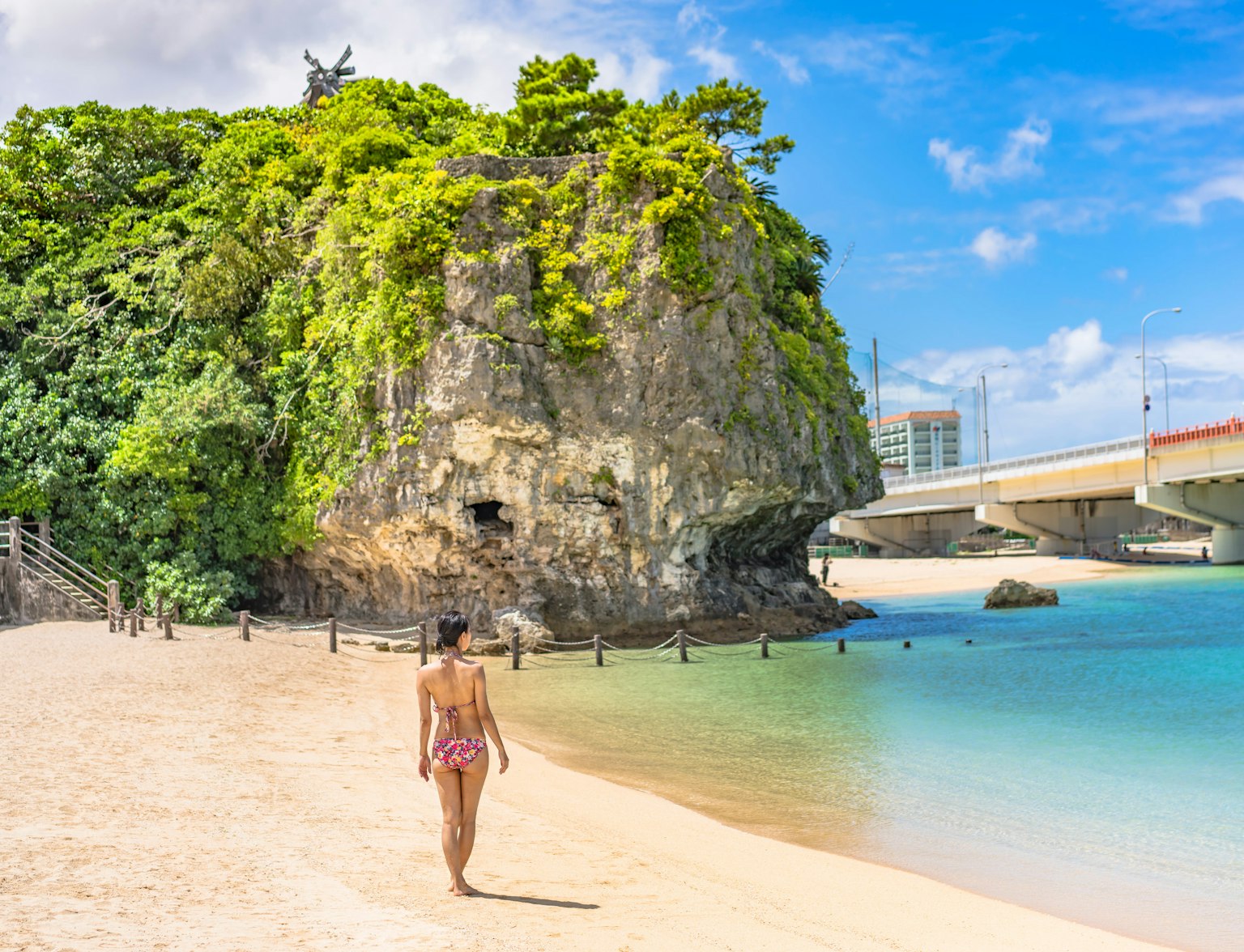
Enjoy the autumn scenery in Okinawa with your chartered vehicle.
Japan is a country that celebrates the changing of seasons with great enthusiasm, and autumn is no exception. As the leaves begin to change color and the temperatures cool, Japan's autumn festivals, known as "Aki Matsuri", offer a vibrant display of cultural traditions, folklore, food, music, and more. From moon-viewing ceremonies to drum festivals, these events provide a unique opportunity to experience Japanese culture at its most festive and colorful.
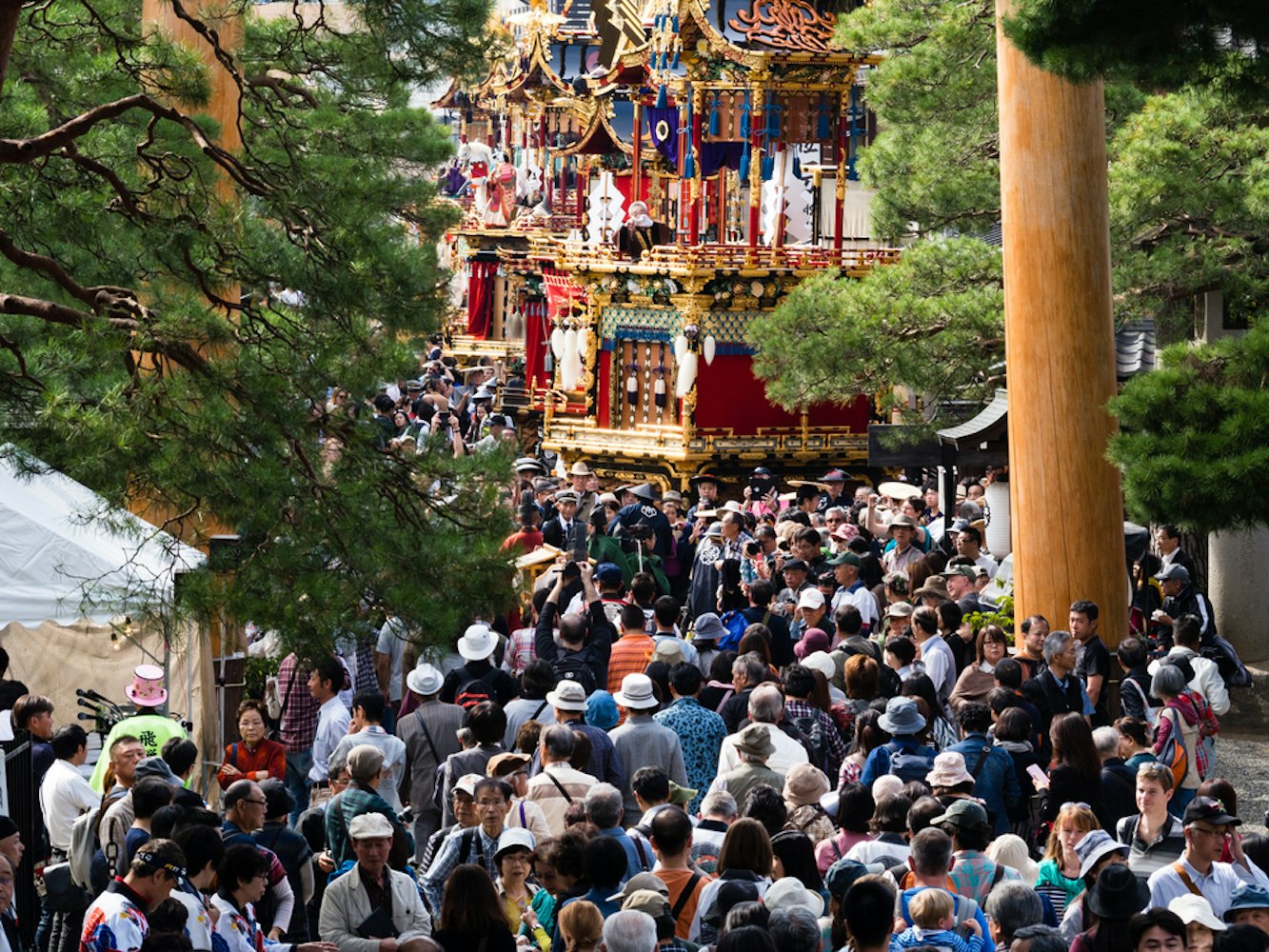
The Takayama Autumn Festival, also known as Hachiman Matsuri, is one of Japan's most beautiful festivals. Held annually on October 9th and 10th in Takayama, Gifu Prefecture, the festival features elaborate floats, traditional music, and performances.
Each year, intricately crafted floats, or "yatai", are paraded through the city streets, showcasing the craftsmanship and artistry of local artisans. These floats, adorned with intricate carvings and lanterns, create a stunning spectacle under the autumn sky.
The festival also includes a traditional puppet show, known as "Karakuri", performed atop the floats. The Takayama Autumn Festival offers a unique blend of folklore and festivities, set against the backdrop of the city's historic streets and autumn foliage.
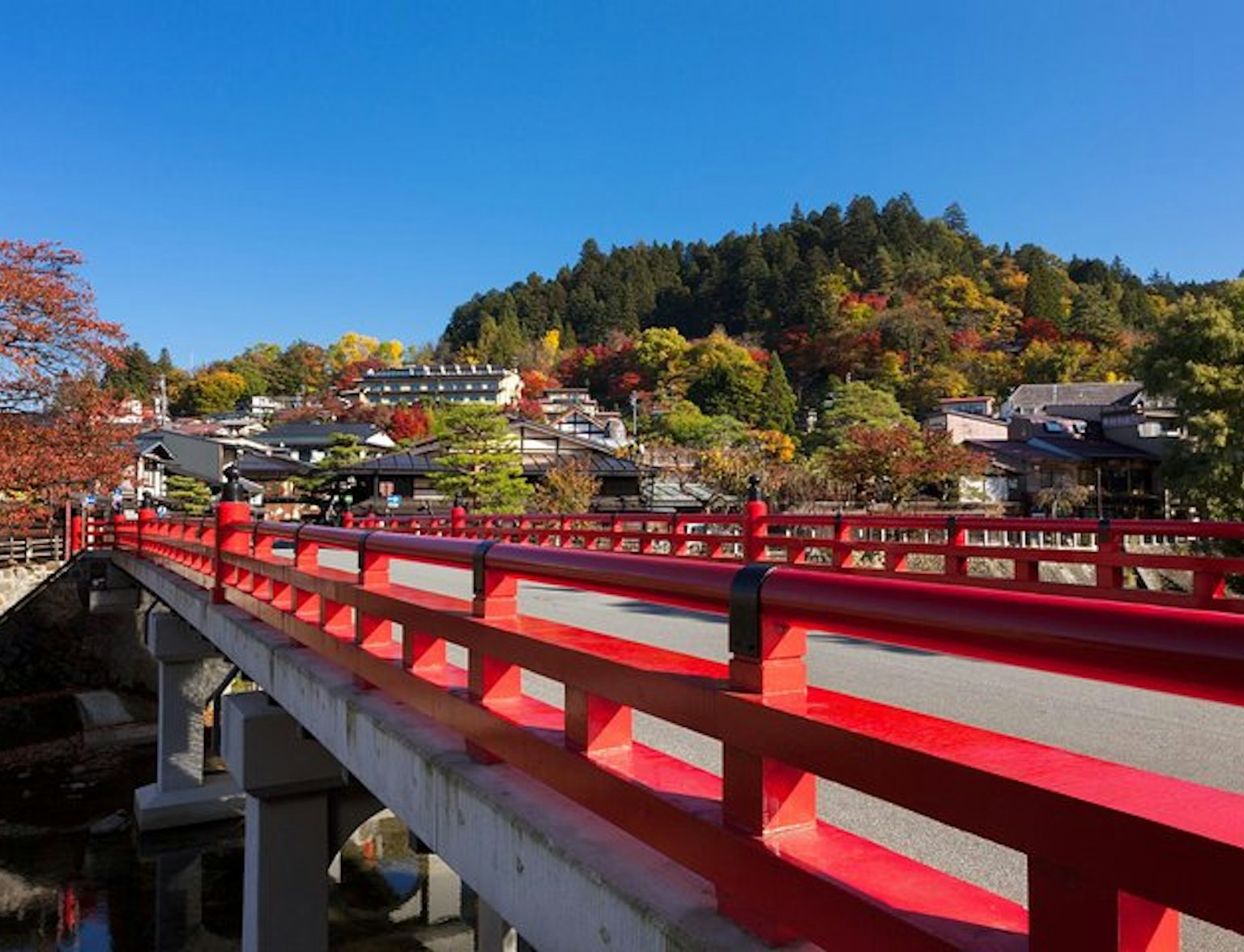
Embark on an exciting journey through the rich history and culture of Takayama's old town!
The Niihama Taiko Festival, held in Niihama, Ehime Prefecture, is one of Japan's most energetic autumn festivals. Known as the "Man Festival", it takes place from October 16th to 18th and features large taiko drums, spirited performances, and processions.
Taiko teams from different neighborhoods carry massive drum floats, or "taikodai", through the streets, showcasing their strength and endurance. These drum floats, weighing up to three tons, are carried on the shoulders of participants to the beat of taiko drums.
The festival is a thrilling display of physical prowess and community spirit, set to the rhythm of pounding drums. The Niihama Taiko Festival offers an unforgettable experience of Japan's autumn festivities.
Autumn in Japan is a spectacle of nature, with vibrant fall colors painting the landscapes. This season, typically from mid-November to early December, offers temperate weather ideal for outdoor explorations.

Planning your autumn trip involves considering various aspects such as accommodation, transportation, and the best spots to experience the autumn foliage. With careful planning, you can ensure a memorable journey through Japan's autumn wonderland.
The peak autumn season in Japan is a popular time for both domestic and international tourists, which means accommodations can book up quickly. It's advisable to reserve your lodgings well in advance to secure your preferred choice. Options range from hotels and ryokans (traditional Japanese inns) to guesthouses and rental apartments.
When selecting accommodations, consider their proximity to areas known for their fall foliage, such as parks, gardens, and forests. Staying close to these sites can allow for early morning or late evening visits when crowds are smaller.
Additionally, some accommodations, particularly ryokans, may offer views of the autumn colors right from your room. Remember to check reviews and ratings before booking to ensure a comfortable stay during your autumn trip to Japan.

Find your way from the airport to your hotel with the help of a local guide.
Japan's public transportation system is efficient and reliable, making it easy to travel around during the autumn season. Trains, buses, and subways can take you almost anywhere in the country. However, certain popular autumn spots may be crowded, so it's advisable to plan your travel times and routes accordingly.
If you're planning to travel extensively by train, consider purchasing a Japan Rail Pass, which offers unlimited travel on most Japan Rail trains for a set period. For more remote areas, renting a car might be a good option. This gives you the flexibility to explore at your own pace and reach off-the-beaten-path autumn spots.
Remember to check the latest local travel advisories, as weather conditions in autumn can occasionally affect transportation. With efficient planning and an understanding of Japan's transportation system, you can navigate smoothly and enjoy the country's stunning autumn landscapes.
Photography during the autumn season in Japan can be a rewarding experience as the country turns into a palette of warm colors. Here are some tips to help you capture the best of this beautiful season:
Time of Day: The "Golden Hour" (the hour after sunrise or before sunset) often provides the best light for capturing the rich colors of autumn leaves. The soft, diffused light can add a warm glow to your photos.
Composition: Look for ways to make your shots interesting. Use the rule of thirds, leading lines, or framing to add depth and interest to your photos.
Perspective: Don't just shoot from eye level - try different angles and perspectives. Get low to the ground, or find a high vantage point for a bird's eye view.
Depth: To give your photos a sense of depth, include elements in the foreground, middle ground, and background. This can make your photos more engaging and three-dimensional.
Reflections: Use bodies of water to capture reflections of the colorful autumn trees. Lakes, ponds, or even puddles can provide beautiful reflections.
Macro Shots: Don't forget to take close-up shots of individual leaves or other small details. These can sometimes be as stunning as the wider landscape shots.
Weather Conditions: Overcast days can actually be quite good for photographing autumn colors, as they can help to saturate the colors. Also, don't be afraid to shoot in the rain - wet leaves can look incredibly vibrant.
Post-processing: Don't hesitate to enhance your photos in post-processing. Adjusting the saturation, contrast, and sharpness can help to bring out the best in your autumn photos.

Experience the beauty of autumn in Tokyo with a professional photographer by your side.
Autumn in Japan is not just a season, it's a unique experience. With the vibrant fall colors painting the landscapes and traditional festivals adding to the cultural richness, there's no better time to explore this beautiful country.
We at TripToJapan are dedicated to making your Japan travel dreams come true. Our curated tours ensure you witness the best of Japan's autumn splendor and create unforgettable memories.
Don't wait too long, as spots fill up quickly for this popular season. Visit our website today to book your tour. Get ready to immerse yourself in the breathtaking beauty and rich cultural tapestry of Japan in autumn. Your Japanese adventure awaits!



